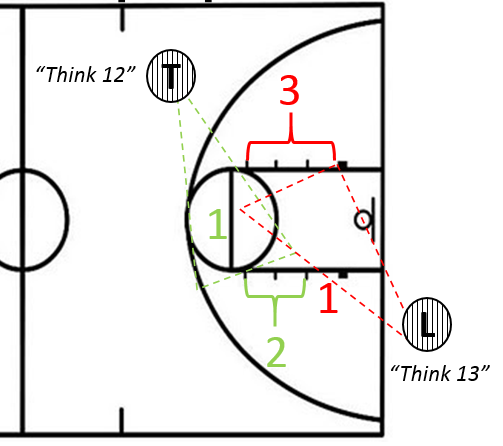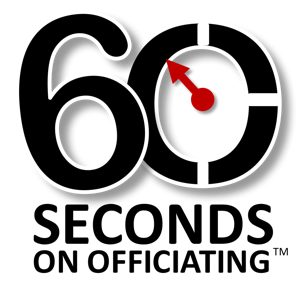
Move to Improve on Free Throws
Tips to maintain a credible calling angle with the new NFHS rule changes.
Starting this year (2014-15) the scholastic games governed by the NFHS rules will permit players in the marked lane spaces to enter the lane when the BALL IS RELEASED by the free thrower. This brings consistency to the collegiate and high school rule sets as it regard these player restrictions.
PRIOR to this change, we at “60 Seconds on Officiating” advocated LESS MOVEMENT in both the trail and lead officials movement when the free throw was released. The basis of this was quite simple. The players were not permitted to move until the ball touched the basket or backboard — therefore, it was best to stay somewhat still until the players moved into the lane area. Not anymore.
Now that restrictions have changed – the timed movement of both officials becomes more important to continue the careful watch of your Primary Coverage Areas (PCA).
Movement should be to IMPROVE your position and MAINTAIN a credible calling angle.
In a scholastic contest there are a couple of tricks to remember what your PCA and lane space responsibilities are using the numbers 12 and 13.
- LEAD: When you are in the lead think UNLUCKY 13. You have the nearest 1st lane space and the 3 opposite lane spaces as your primary responsibility. Get it … 13. First nearest and 3 opposite.
- TRAIL (2 Person Crew) or CENTER (3 Person Crew): Think DOZEN. You have the 1 free thrower and the 2 opposite lane spaces as your PCA. Same idea but 12. Thrower (which is 1) and the 2 opposite lane spaces.

As the official opposite the table your visual angle should be to make sure you see clearly the thrower and the players in the opposite two lane spaces. Now since players can be entering the lane on release you will need to STEP DOWN as the ball is released to maintain this optimal viewing angle. Where in prior years it was more advantageous to wait until the ball touched the basket before moving – the time has shifted earlier. Think about taking your single step down toward the basket as these players fill the lane.
The lead official (typically table side) will also step toward the basket line while still maintaining their depth and angle on the nearest lane space and the opposite three spaces. (Remember 13 ?)
Movement should be SMOOTH and NOT PRIOR to the release of the free throw.
Both officials should come to a complete STOP as the ball nears the basket area and prepare to whistle any violations or fouls.
Additionally the TRAIL (or CENTER) Official opposite the table should be cognizant of not only the free thrower but also the players outside the 3 point arc and not in marked lane spaces. The restrictions remain in effect until the free throw touches the ring / backboard or the free throw ends.
A few best practices to remember include:
- Signal a delayed-dead ball if the opponent of the free throwing team violates first and let the play finish before sounding your whistle if missed.
- Use a sharp / quick whistle when the free thrower (or teammate) violates first.
- The outside official (trail in a 2 person crew / center in a 3 person crew) will provide a “small” visible count when the ball is at the disposal of the free thrower – watching for 10 second violations, then raise this same arm (closest to the division line) to signal the starting (chop) of the clock, when appropriate.
- Lead officials should rarely (if ever) rule on a free throw violation involving the ring or backboard. That’s primarily the outside official — but if missed, any official can get the play right.
- On a made free throw and the ball will now be inbounded — the outside official will merely drop their arm (not chop – just lower slowly) and the lead official will raise their arm to hold the clock as the team retains the ability to run the endline for the throw-in.
- In a two person crew – the Trail should also keep a look-out for substitutions. It’s much easier in a three person crew as the table side official will handle substitutions coming from the table.
These scholastic rule changes should allow officials to better monitor violations and fouls as they occur during free throw attempts. Just keep in mind — move to improve as the action gets underway and the ball is released. You will enjoy the new perspective in the game.
NFHS Rule Reference: 9-1-3g

“60 Seconds on Officiating”, and “Beyond the Rules I & II” have become excellent resources in my Basketball Ref arsonal. They have helped me to step up my game quite a few notches.
The picture associated with your instructions on free throws tells a story, which is becoming the norm. It appears the the lead official while correct in closing down on the shot, appeared to be way too wide on the baseline in the first place.
Why are more and more officials as lead on free throws backing up on the baseline closer to or right at the intersection of the baseline and the three point line? The book says four feet off the closer lane space.
Good comment on the “position of the lead” as it relates to the endline and sideline. Here’s what I teach the cadets.
Always take a position with two important aspects. ANGLE and DISTANCE.
Angle: They always should be able to see the THREE LANE SPACES that are opposite. If you go too wide, the near lane space will block you out. Instead of going wide … get some depth off the endline, if you feel too close.
Distance: Never too far away, or too deep. Just enough to open up your peripheral vision to see the “whole play” and step in, as the players converge on the release.
Thanks for the insight … and sharing the book suggestions on positioning.
Great to have you back. This site is a great resource for my cadets. The step down technique is something that high school officials are going to have to make part of their arsenal of mechanics now that the rules have changed for the players in the lane. Great observation by Ace. I see too many officials who stand like the one in the picture. I also have a problem with the trail who on a free throw stands close to the division line so as not to get beaten down the court as he or she transitions into the lead. There is no way you can adequately watch the shooter for violations from that angle.
As a cadet, I look forward to implementing these techniques/mechanics.
“■Signal a delayed-dead ball if the opponent of the free throwing team violates first and let the play finish before sounding your whistle if missed.” – this is not always correct. It depends on whether or not there is a subsequent violation by the free throwing team, and where that person is. If he is the free thrower or a teammate of his beyond the three point line – it’s an immediate dead ball, no points scored, and either remaining free throws are administererd or you fo to the possession arrow. if both violators are in the lane, and the opponent violates first, the second is ignored and you do signal a delayed dead ball.
I anticipate some problems early in the season – I just did a scrimmage game and even after explaining the rule before the opening toss, and again when administering the first few free throws, I had constant violations from the players beyond the arc coming in on the release.And some “that’s not fair” comments when I gave the ball to the free throwing team for a throw in (as they had the possession arrow) in one case, and the oppenents in another (again, the arrow had changed)…
The rule book does not explain the penalty for all scenarios, either. For instance:
Violation first by opponent beyond the arc, then by teammate of freethrower in the lane.
In fact – an interesting end-of-game strategy: Team A is down by 3 points with clock down to final seconds. Team A also has posession arrow. Team B fouls Team A with 2 seconds left to prevent a 3-point shot. Team A hits the first free throw, and would normally have to miss the second on purpose and hope for a tip-in. However, Team B violates before the second free throw, by coming into the lane to fill a space late, or a player beyond the arc comes in too soon. A savvy Team A foul shooter then steps over the line while shooting the second shot. Bingo! Team A gets the ball under the basket with 2 seconds to get off a shot…
Great Article and Mechanic advise for the new rule. The question I want to ask is, (as in the picture provided) all the lane occupiers have their arms extended in front of their opponents with the obvious attempt to impede their progression into the lane. Is this legal? Or do the players have to maintain their body parts in the lane that is provided for them?
@Jeff Rabold … provided the hands remain in their own marked lane space (vertical area) until the release of the free throw — I see this as incidental contact as long as the player is not holding their opponent to create a disadvantage. If before the release, then a violation may be ruled on either (or both) player(s).
Looking forward to your weekly topics. Over the years, I have found this forum to be of great help.
Thank You Billy Martin for your time and help all this info is really helpful thank you very much.
Appreciate the dialog. Especially the value of stepping down after the free throw.